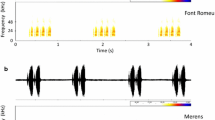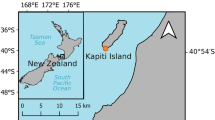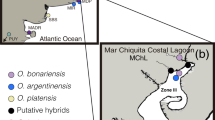Abstract
An earlier study of population genetics of an estuarine amphipod provided evidence from genomic DNA analysis for a habitat-specific race of amphipods within the speciesEogammarus confervicolus. In some estuaries of the northeast Pacific, this race of amphipods exists sympatrically with other members of the species. Here we present evidence for a race-specific pheromone that appears to be the consequence of differential metabolism of the algae (Fucus distichus andPelvetia fastigiata) characteristic of the habitat occupied by this race. The race-specific pheromone identified in this study is a subtle modification of an already existing communication system: females of the habitat-specific race produce the pheromone characteristic of the species as a whole but have an ability not shared by other females of the species to modify this pheromone when raised on the algal substrate characteristic of their habitat. Only males of this race make a distinction between the more specific pheromone and the species pheromone. The formation of hybrids (conceived and raised on the algal substrate) between members of the habitat-specific race and the other members of the species disrupted the ability to produce and distinguish the race-specific pheromone; hybrids still produced a pheromone, but it was indistinguishable from that produced by the species as a whole. Behavioral assays and the results of reciprocal, interpopulation crosses indicated pheromone response in males had evolved with production; males however, did not have to be raised on the algal substrate to respond to the alternate pheromone. No evidence for maternal effects or sex linkage were detected in the results of the crosses; more specific indications of the genetics underlying pheromone production were not evident.
Similar content being viewed by others
References
Averhoff, W.W., andRichardson, R.H. 1976. Multiple pheromone system controlling mating inDrosophila melanogaster.Proc. Natl. Acad. Sci. U.S.A. 73:591–593.
Bedard, W.D., Tilden, P.E., Wood, D.L., Silverstein, R.M., Brownlee, R.G., andRodin, J.O. 1969. Western pine beetle: Field response to its sex pheromone and a synergistic host terpene myrcene.Science 164:1284–1285.
Bedard, W.D., Wood, D.L., Tilden, P.E., Lindahl, K.Q., {jrJr.},Silverstein, R.M., Brownlee, R.G., andRodin, J.O. 1980. Field responses of the western pine beetle and one of its predators to host and beetle produced compounds.J. Chem. Ecol. 6:625–641.
Bengtsson, B.O., andLofstedt, C. 1990. No evidence for selection in a pheromonally polymorphic moth population.Am. Nat. 136:722–726.
Borowsky, B. 1984. Effects of receptive females’ secretions on some male reproductive behaviors in the amphipod crustaceanMicrodeutopus gryllotalpa.Mar. Biol. 84:183–187.
Borowsky, B. 1985. The responses of males and females to each other’s secretions in the amphipod crustaceanGammarus palustris.J. Chem. Ecol. 11:1545–1552.
Borowsky, B., andBorowsky, R. 1987. The reproductive behaviors of the amphipod crustaceanGammarus palustris (Bousfield) and some insights into the nature of their stimuli.J. Exp. Mar. Biol. Ecol. 107:131–144.
Borowsky, B., Augelli, C.E., andWilson, S.R. 1987. Towards chemical characterization of waterborne pheromone of amphipod crustaceanMicrodeutopus gryllotalpa.J. Chem. Ecol. 13:1673–1680.
Bousfield, E.L. 1979. The amphipod superfamily Gammaroidea in the northeast Pacific region: Systematics and distributional ecology.Bull. Biol. Soc. Wash. 3:297–357.
Cardé, R.T. 1986. The role of pheromones in reproductive isolation and speciation in insects, pp. 303–317,in M.D. Huettel (ed.). Evolutionary Genetics of Invertebrate Behavior. Plenum, New York.
DeWitt, T.H. 1987. Microhabitat selection and colonization rates of a benthic amphipod.Mar. Ecol. Prog. Ser. 36:237–250.
Diehl, S.R., andBush, G.L. 1989. The role of habitat preference in adaptation and speciation, pp. 345–365,in D. Otte and J.A. Endler (eds.). Speciation and its Consequences. Sinauer Assoc, Sunderland, Massachusetts.
Dunham, P. 1978. Sex pheromones in Crustacea.Biol. Rev. 53:555–583.
Fenchel, T.M., andKolding, S. 1979. Habitat selection and distribution patterns of five species of the amphipod genusGammarus.Oikos 33:316–322.
Fincham, A.A. 1972. Rhythmic swimming and rheotropism in the amphipodMarinogammarus marinas.J. Exp. Mar. Biol. Ecol. 8:19–26.
Goodman, D., andVroom, P.R. 1972. Investigation into fish utilization of the inner estuary of the Squamish River. Fish. Serv. Manuscr. Rep. 1972-12.
Grant, G.G., Frech, D., andGrisdale, D. 1975. Tussock moths: Pheromone cross stimulation, calling behavior, and effect of hybridization.Ann. Entomol. Soc. Am. 68:519–524.
Grula, J.W., andTaylor, O.R., {jrJr.} 1979. The inheritance of pheromone production in the sulphur butterfliesColias eurytheme andC. philodice.Heredity 42:359–371.
Hargrave, B.T. 1970. The utilization of benthic microflora byHyalella azteca (Amphipoda).J. Anim. Ecol. 39:427–437.
Hay, M.E., Duffy, J.E., andPfister, C.A. 1987. Chemical defense against different marine herbivores: Are amphipods insect equivalents?Ecology 68:1567–1580.
Klun, J.A., andHuettel, M.D. 1988. Genetic regulation of sex pheromone production and response: Interaction of sympatric pheromonal types of the European corn borer,Ostrinia nubilalis (Lepidoptera: Pyralidae).J. Chem. Ecol. 14:2047–2061.
Klun, J.A., andMaini, S. 1979. Genetic basis of an insect chemical communication system: The European corn borer.Environ. Entomol. 8:423–426.
Kneib, R.T. 1982. Habitat preference, predation, and the intertidal distribution of gammaridean amphipods in a North Carolina salt marsh.J. Exp. Mar. Biol. Ecol. 59:219–230.
Kolding, S. 1981. Habitat selection and life cycle characteristics of five species of the amphipod genusGammarus in the Baltic.Oikos 37:173–178.
Kostalos, M.S., andSeymour, R.L. 1976. Role of microbial enriched detritus in the nutrition ofGammarus minus (Amphipoda).Oikos 27:512–516.
Levy, D.A., andLevings, C.D. 1978. A description of the fish community of the Squamish River estuary, British Columbia: Relative abundance, seasonal changes and feeding habits of salmonids. Fish. Mar. Ser. Manuscr. Rep. 1475.
Miller, S.A. 1984. Seasonal activity patterns ofGammarus pseudolimnaeus Bousfield (Amphipoda).Crustaceana 46:135–147.
Pena, A., Arn, H., Buser, H.-R., Rauscher, S., Bigler, F., Brunetti, R., Maini, S., andToth, M. 1988. Sex pheromone of European corn borer,Ostrinia nubilalis: Polymorphism in various laboratory and field strains.J. Chem. Ecol. 14:1359–1366.
Rice, W.R. 1984. Disruptive selection on habitat preference and the evolution of reproductive isolation: A simulation study.Evolution 38:1251–1260.
Rice, W.R., andSalt, G.W. 1990. The evolution of reproductive isolation as a correlated character under sympatric conditions: Experimental evidence.Evolution 44:1140–1152.
Roelofs, W.L., Glover, T., Tang, X.-H., Sreng, I., Robbins, P., Eckenrode, C., Lofstedt, C., Hansson, B., andBengtsson, B.O. 1987. Sex pheromone production and perception in European corn borer moths is determined by both autosomal and sex-linked genes.Proc. Natl. Acad. Sci. U.S.A. 84:7585–7589.
Sanders, C.J., Daterman, G.E., andEnnis, T.G. 1977. Sex pheromone responses ofChoristoneura spp. and their hybrids (Lepidoptera: Tortricidae).Can. Entomol. 109:1201–1220.
Sharp, P. 1980. Culture studies onEogammarus confervicolus (Amphipoda: Anisogammaridae). MSc thesis. University of British Columbia, Vancouver, British Columbia.
Stanhope, M.J. 1989. Natural selection of life history traits in an estuarine amphipod. PhD thesis. Simon Fraser University, Burnaby, British Columbia.
Stanhope, M.J., andLevings, C.D. 1985. Growth and production ofEogammarus confervicolus (Amphipoda: Anisogammaridae) at a log storage site and in areas of undisturbed habitat within the Squamish estuary, British Columbia.Can. J. Fish. Aquat. Sci. 42:1733–1740.
Stoner, A.W. 1980. Abundance, reproductive seasonality and habitat preferences of amphipod crustaceans in seagrass meadows of Apalachee Bay, Florida.Contr. Mar. Sci. 23:63–77.
Sturgeon, K.B., andMitton, J.B. 1986. Allozyme and morphological differentiation of mountain pine beetlesDendroctonus ponderosae Hopkins (Coleoptera: Scolytidae) associated with host tree.Evolution 40:290–302.
Sutcliffe, D.W., Carrick, T.R., andWilloughby, L.G. 1981. Effects of diet, body size, age and temperature on growth rates in the amphipodGammarus pulex.Freshwater Biol. 11:183–214.
White, M.J.D. 1978. Modes of Speciation. W.H. Freeman & Co., San Francisco.
Williams, D.D., andMoore, K.A. 1986. Microhabitat selection by a stream-dwelling amphipod: A multivariate analysis approach.Freshwater Biol. 16:115–122.
Zar, J.H. 1974. Biostatistical Analysis. Prentice-Hall, Inc., Englewood Cliffs, New Jersey.
Author information
Authors and Affiliations
Rights and permissions
About this article
Cite this article
Stanhope, M.J., Connelly, M.M. & Hartwick, B. Evolution of a crustacean chemical communication channel: Behavioral and ecological genetic evidence for a habitat-modified, race-specific pheromone. J Chem Ecol 18, 1871–1887 (1992). https://doi.org/10.1007/BF02751110
Received:
Accepted:
Issue Date:
DOI: https://doi.org/10.1007/BF02751110




